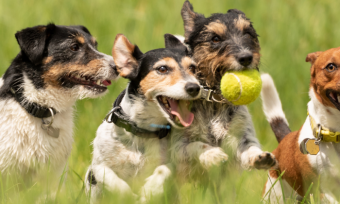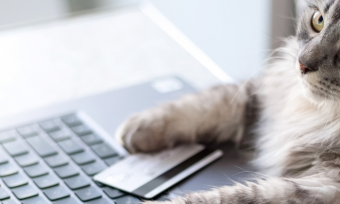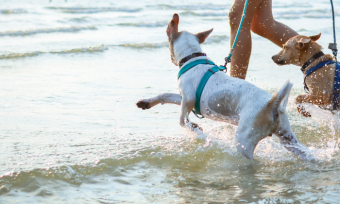
Our recent periods of social isolation thanks to COVID meant more quality time at home with our furry friends. In fact, shelters around the country (and globally) saw pet adoptions increase as people looked for companionship to help support and improve their mental health during the pandemic.
For social animals like dogs, cats and even birds, the extra playtime, walks and snuggles were more than welcome. So it’s no wonder that now lockdowns are behind us, many pets and owners alike are dealing with separation anxiety.
If you’re feeling anxious about how your furry companion is responding to a sudden empty house or change of schedule, read on to learn how to help your pet cope with separation anxiety.
Separation anxiety in pets: what is it?
Your pet is a key family member – they know so and they love it. The bond you build with them has long-lasting benefits for both you and your family.
Unfortunately, we can’t be with them all the time, and sometimes our pets are left home alone, which is when separation anxiety can occur.
This can lead to your pet exhibiting a range of different behaviours.
Sometimes separation anxiety in pets can be misdiagnosed, so it’s best to have a chat with your vet about what’s going on if you notice unusual behaviour. Boredom, lack of physical and mental stimulation, alarm barking and lack of suitable chew and scratch toys can also lead to some destructive behaviours.
Separation anxiety in pets: key triggers
There are numerous triggers for separation distress in animals, although some more common ones include a pet:
- Being left alone for the first time, or way too often (dogs get more stressed than cats about this)
- Being left alone when it is accustomed to constant human contact
- Suffering trauma, e.g., being lost, spending time at a shelter or pet boarding facility (during a holiday)
- Trying to adapt to a change in its family’s routine or structure, the loss of senior pet parents or other pets/companions
If this sounds familiar, your pet could very well be suffering. Let’s look at the signs to watch out for.
Symptoms of and treatment for separation distress
Symptoms of stress and anxiety can differ between breeds and animal types, so we’ve listed a few common indicators that your pooch or puss is missing you.
Separation anxiety symptoms in dogs
All dogs are different – they may react to being left at home by showing one, some or all of the below behaviours. Further, certain breeds are predisposed to nervous behaviours, which can exacerbate separation anxiety.
Your pup may do any of the following or similar:
- Try to break out of your house or yard when left alone, searching for you
- Become destructive in search of attention, scratching on walls, doors and biting furniture
- Leave you little ‘surprises’ inside, even when toilet trained
- Develop nervous behaviours, like excessive pacing, grooming or whimpering
→Related article: How to Select the Right Dog Breed for You
Helping canines overcome isolation distress
Pre-departure anxiety is common in dogs, as they learn the cues that lead to you leaving. But by carefully working through these stress points with your dog, you can de-sensitise your dog to these cues.
We suggest you:
- Expose your pup to the normal leaving ritual, but don’t leave right away
- Work up to walking toward the door and touching the handle, then sit back down
- Progress to opening the door, stepping out, for longer and longer periods of time, and coming back in
- Leave for short periods, telling them in a soothing voice that you’ll be leaving now, then extend this over time until they’re comfortable with being at home
If you’re short on time, you might also try these tips:
- Ask friends, family or get a pet sitter to help you with your desensitisation, or stay with your pup while you’re away
- Don’t reward attention-seeking behaviour, and try to ignore your dog 15-30 mins prior to you leaving. Reward them for being calm and relaxed
- Provide them with blankets or laundry with your scent, and provide safe chew toys, or toys filled with food to occupy them while you’re gone
- Book your pooch into reputable doggy day care services in your area
- Ensure your dog is getting enough attention and exercise before and after you leave them alone
→Related article: The Best Apps for Pet Owners
Separation anxiety in cats
We all know how aloof many cats can be, but most are social creatures who form deep bonds with their pet parents. So, when you go away on vacation or leave them for work often throughout the week, they may begin to fret that they won’t see you again.
They can display any of these signs of anxiety:
- Pine and refuse food while you are gone
- Meow, cry or vomit after you’ve left
- Mark your home/furniture with urine and/or defecate inside
- Begin excessive hair grooming, which can become compulsive
- Show signs of reoccurring stress and develop reoccurring cystitis, urinating little or often – including outside the litter tray
- Claw or scratch door edges in an attempt to escape their confinement
Helping your kitty cope while you’re away
Just like dogs, cats too can recognise leaving cues and may follow you from room to room before you go, seeking reassurance. Cats can be good at masking their symptoms of separation anxiety, but if they begin doing any of the above, then speak to your vet.
The following might help keep your cat distracted and happy while you’re out:
- Quality, climbing frames and cat-safe shelving to help your kitty find a good view of the outside world
- Scratching posts and food puzzle toys with their day’s ration of food in it (be aware of overfeeding)
- An assortment of mobile toys enhanced with catnip
- Leaving the radio or television on
- Reduce the shock of you leaving by ignoring them for 15-30 minutes prior to doing so

Pet separation anxiety medication
If none of the above steps work, you’ll need to speak with your vet. They may suggest anti-anxiety medication or pheromone therapy. There are several drugs available for all manner of dog anxiety and cat anxiety issues.
You could potentially explore homeopathic and herbal remedies too – again, there’s a wide range available.
Managing pet parent separation anxiety
Pets are highly sensitive and will pick up on any anxiety you have about leaving them, too, so it’s important you stay calm and composed before you leave, and also when you come home. Greet them calmly, without making a huge fuss.
We know that can be hard, but it’s best for them and for you if either of you are dealing with anxiety issues.
Plus, if you’re an overprotective pet parent, and you never leave your pet’s side, or shower them with too much love and attention – this will exacerbate any separation distress they experience.
If this sounds like you, then you’ll need to make changes to your behaviour, too. But don’t worry – the best pathway is to do it gradually, so you can both get used to it. Choosing to take more time for yourself without your pet will help both of you deal with separation anxiety when you don’t have a choice but to fly solo.
Compare pet insurance with Canstar!

About the reviewer of this page
This report was reviewed by Canstar Content Producer, Andrew Broadley. Andrew is an experienced writer with a wide range of industry experience. Starting out, he cut his teeth working as a writer for print and online magazines, and he has worked in both journalism and editorial roles. His content has covered lifestyle and culture, marketing and, more recently, finance for Canstar.
Enjoy reading this article?
You can like us on Facebook and get social, or sign up to receive more news like this straight to your inbox.
By subscribing you agree to the Canstar Privacy Policy






Share this article